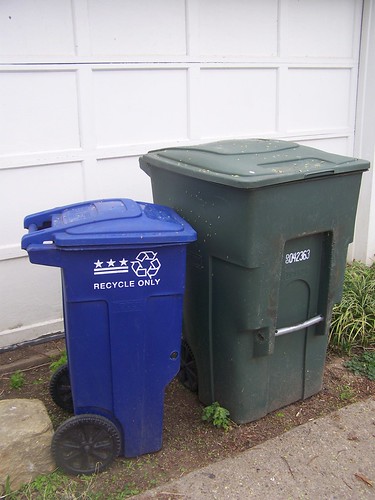Starting new "sustainable" waste collection practices wastefully
Yesterday, DC announced that the city will be replacing the trash and recycling waste collection cans for the entire city. In the outer city, all existing 96-gallon cans will be replaced with new 96-gallon cans, and 32-gallon recycling cans will be replaced with 64-gallon recycling cans.
In the core city, people will get new 32-gallon trash cans and bigger 48-gallon recycling cans.
I like getting a bigger recycling can. For our house that's a good thing because I use up the 32- gallon capacity every week and often on Wednesday morning I furtively stick stuff in cans belonging to other households. But ...
 it's a huge waste to replace the trash cans like for like when upwards of 95% of the current cans might be old but they are fully serviceable.
it's a huge waste to replace the trash cans like for like when upwards of 95% of the current cans might be old but they are fully serviceable.Right: my trash and recycling cans. I am happy to get a new, bigger recycling can because I need it, but our trash can is good for many more years, as are most--not all, some are missing lids or are partially broken--of the trash cans on the blocks in my neighborhood.
Sure the plastic can be recycled, but it's still a waste.
I don't understand why the city doesn't replace the broken cans and keep the ones that are serviceable.
In "A way for DC to begin adding yard waste collection as a separate element of waste collection and reduction programming" I outlined a different way for the city to deal with waste collection, to integrate yard waste reduction and collection and even composting within the current waste collection system.
 Left: Salt Lake City has three types of waste collection cans, for yard waste, trash, and recyclables. In addition they have one day each year that is for bulk pick up, and people are allowed to pick these discards before the city hauls them away.
Left: Salt Lake City has three types of waste collection cans, for yard waste, trash, and recyclables. In addition they have one day each year that is for bulk pick up, and people are allowed to pick these discards before the city hauls them away.But that's not the direction the city is moving in.
As I wrote in "Realizing all aspects of Sustainable DC", despite the city's lofty sustainability goals to make DC the "healthiest, greenest, most livable city in the nation," which in terms of waste collection means a target of 80% diversion:
Mayor Gray noted that by increasing capacity for residents to recycle, the District takes a significant step toward achieving the Sustainable DC Plan’s target of diverting 80 percent of the waste stream through recycling, composting, and waste conversionby adopting laggard wasteful and unsustainable policies and practices rather than innovative policies and practices, there is no way that the city can reasonably expect to reach these kinds of goals.
Now sure, I know the people would get fired for raising the issue, but shouldn't the first question that is asked in terms of these kinds of policies be:
Is this the most forward practice that we can adopt?
Followed by:
what are other cities doing?
and
are we proposing to go about this change in the most sustainable, cost efficient fashion?
Clearly these kinds of questions aren't being asked, and they aren't occurring to journalists either, e.g., "New recycling and trash bins coming to DC households" from the Washington Post.
Labels: change-innovation-transformation, green-environment-urban, organizational behavior, provision of public services, sustainability, sustainable land use and resource planning



0 Comments:
Post a Comment
<< Home